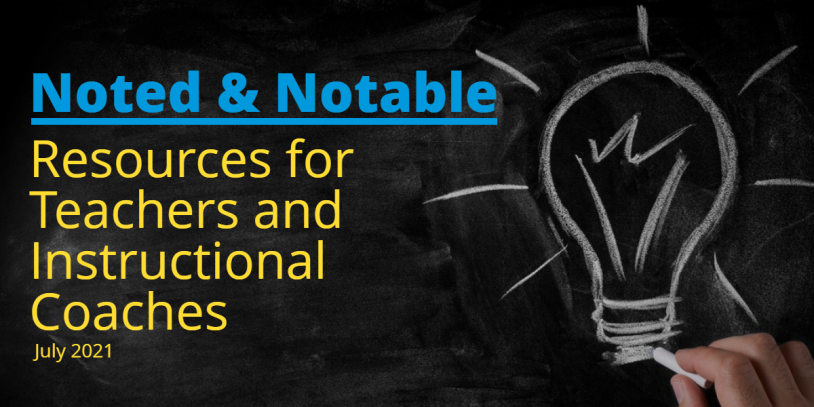Resources for Teachers and Instructional Coaches – July 2021

It’s July and hopefully, educators are resting and recharging. For those looking to continue their personal and professional learning on their own, we have some top July reads and resources. From teaching Black history year-round to social and emotional wellness for teachers, we have highlights and article links for you–easy to read, even beachside.
Don’t confine teaching about Black history to February
During Black History Month, resources for teaching about Black history abound. But what about the other 11 months of the year? Teaching Black history is important to do year-round, and doing so with “rigorous sight” is key. Here is a breakdown of what that means and what it looks like for teachers:
In his book Fugitive Pedagogy, Dr. Jarvis Givens created the term rigorous sight, which encourages educators to investigate all aspects when teaching Black history. According to Givens, rigorous sight is a disciplined and vigilant practice of intellectual inquiry into power dynamics and anti-Blackness as well as into the life and culture of Black people through conceptual engagement with their lived experiences. In other words, it’s teaching through the lens of the Black experience in America and asking questions.
1. Incorporate Black people. This may seem simple to the point of absurdity, but in the spirit of keeping things simple, don’t think too hard. Identify Black people who’ve had an impact in whatever subject you’re teaching.
2. Incorporate Black perspectives. Incorporating Black people within your curriculum is fairly simple to do. Using the previous example, if studying the Romantic period in American literature, read Black Romantic writers. That offers some perspective. But how do you get that perspective in the other content areas? You can start by using texts written by Black authors to cover your year of content.
3. Incorporate the Black community. Black history isn’t a relic of the past. Black history is living and breathing; Black people make history every day, including Black people in your local community.
Read more on Edutopia: Teaching Black History Year-Round Requires Rigorous Sight
You can also read more on the Edthena blog about productively discussing topics such as Black Lives Matter with students.
Normalize family engagement
Teacher-family connection grew in unexpected ways (for the better) during distance learning this past school year. Now’s the time for educators to take what they learned and bring it into the new year. Here’s more from ASCD about how to prioritize family engagement moving forward.
Thus, the “liberatory” aspect of parent engagement focuses on equity while leveraging this newly forged school-home union. Indeed, prior to the coronavirus, the report observes that many families were overlooked and devalued, or treated as spectators in their child’s education. The new post-pandemic approach should be asset-based to recognize the variety of strengths parents can provide to student learning. Moreover, engagement needs to be collaborative and codeveloped by educators and families, and it should be systemically embedded so it is not perceived as an add-on but is an accepted part of good practice.
[J]ust as there is a new appreciation for the professional development educators need to deliver effective instruction in various modalities—virtual, in-person, hybrid—there is also greater recognition of the need to embed parental engagement PD into induction programs. Because so many students attended school from home this past year, utilizing parents as true instructional partners is now both more accepted and effective.
Read more at ASCD: Making COVID-Era Family Engagement the ‘New Normal’ for Schools
Initiatives for addressing teacher stress
It’s no surprise to anyone that teachers are stressed. But what can educators and school leaders do about it? A lot, actually. Schools can prioritize supporting teachers by addressing their social, emotional, and mental wellness. Take a look at ways to do this:
Nearly one in four teachers said they were likely to leave their jobs this summer according to a recent survey from the Rand Corporation.
“We found that teachers are experiencing frequent job-related stress and symptoms of depression at far higher rates than the general adult population,” says Ashley Woo, an assistant policy researcher at RAND, and co-author of the report based on the survey.
The report provided several recommendations for reducing teacher stress. These include:
- Implementing recommended COVID-19 mitigation measures
- Using American Rescue Plan funds to provide mental health supports for staff
- Providing access to childcare for educators by having state leaders include teachers in their essential worker designations
- Developing clear policies for remote teaching and necessary training support if remote teaching is implemented on a long term basis
- Collecting data on teaching and well-being.
For teachers, Schlund recommends three steps:
- “Set aside regular time to take stock of your needs. For example, by reflecting on your own social and emotional competencies, using a self-care inventory and plan, or recording feelings and reflections in a journal,” she says. “Build on these reflections by creating a plan for how to strengthen areas of growth or ensure self-care needs are met, then find a trusted colleague to check in regularly on each other’s plans.”
- “Reconnect with why you teach and identify a group of supportive colleagues who want to collaborate and work together on shared goals. Even if your school doesn’t have formal structures set up for meaningful collaboration, you can use planning times to consult with each other on challenges, connect with mentors, or discuss helpful articles.”
- “Talk with your school administrator about the importance of schoolwide SEL for both students and adults, and ask what you can do to help bring SEL to your school,” Schlund says. “Many SEL initiatives have been started by one passionate teacher who sparked a schoolwide focus on SEL.”
Read more on Tech & Learning: How to Reduce Teacher Stress
Also check out why Pedro Noguera told us sometimes it’s OK for teachers to be worried.
Missed our June Notable Content? Find it here!

